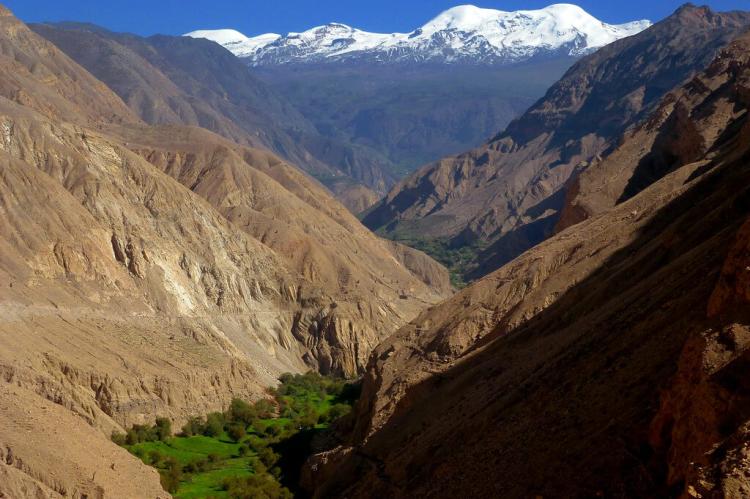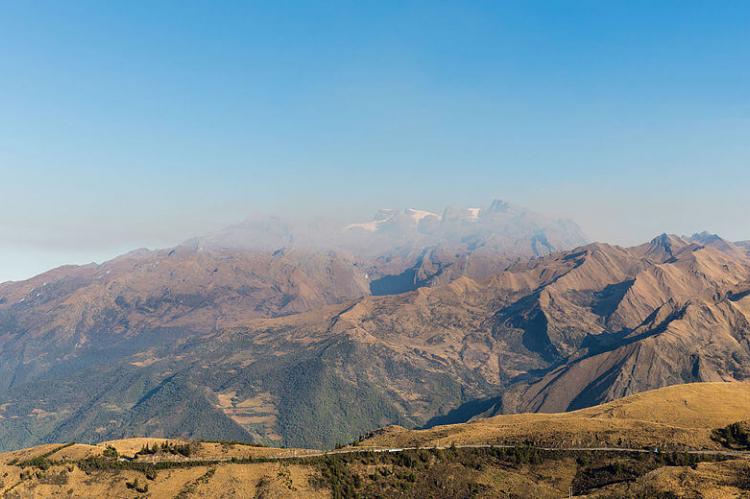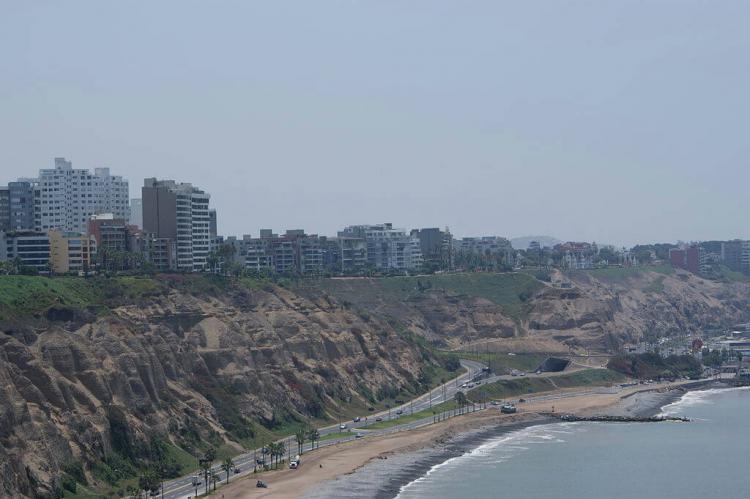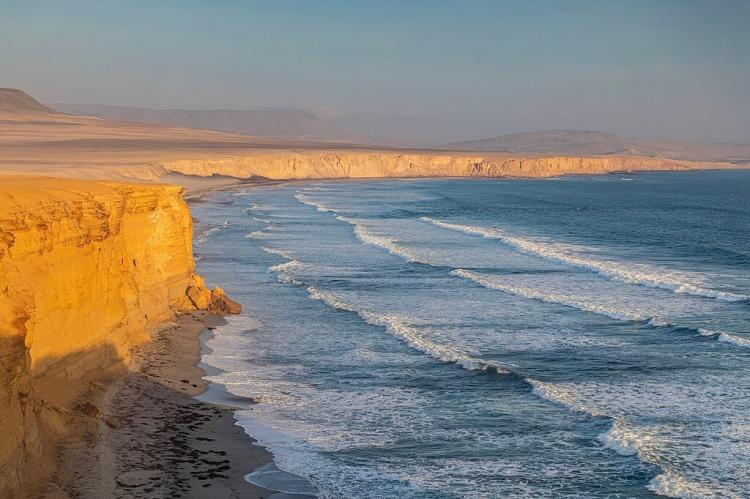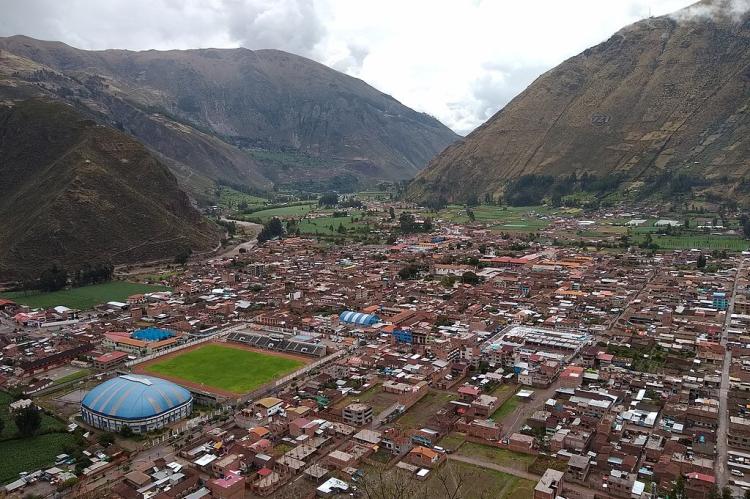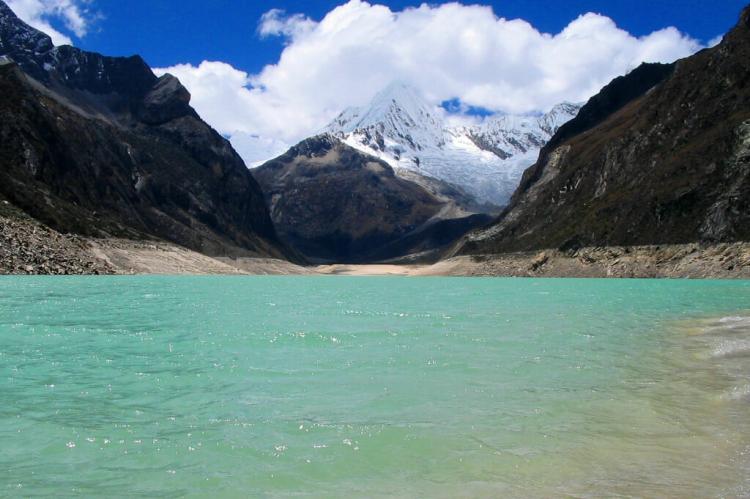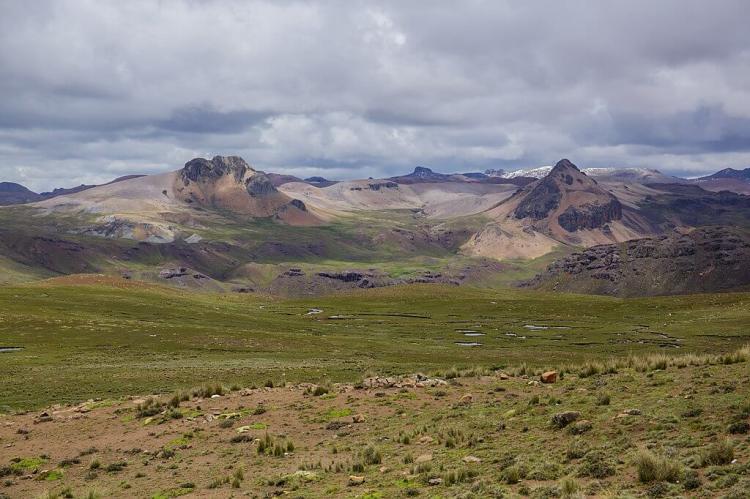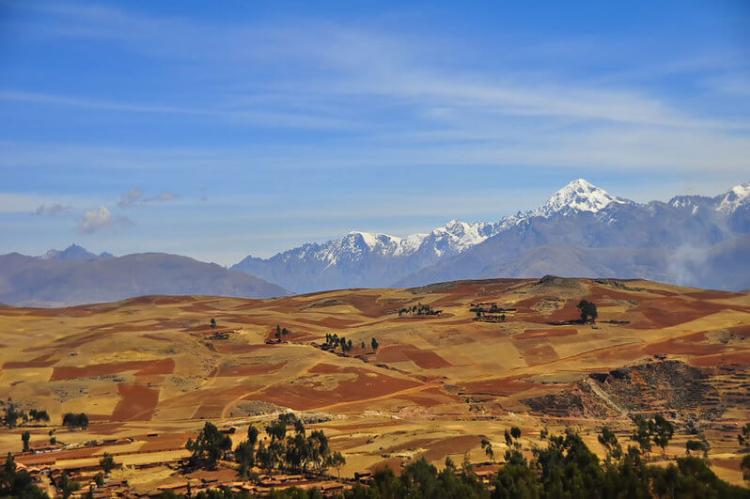Peru: Natural Landscape
Located on the western coast of South America, Peru is one of the world's most biologically diverse countries. Its biodiversity can be organized into four main biomes. Geographically, Peru is traditionally described in terms of three broad longitudinal regions: the Costa, the Sierra, and the Amazonia.
The Natural Landscape of Peru
Peru, a country steeped in rich history and diverse landscapes, occupies a prominent position on the central western coast of the South American continent. The nation boasts a captivating geographical diversity, with its western edge adorned by a mesmerizing 2,400-kilometer (1,500-mile) stretch of Pacific coastline.
Bordered by Ecuador to the northwest, Colombia to the northeast, Brazil to the east, Bolivia to the southeast, and Chile to the south, Peru stands as a meeting point of cultures and a nexus of regional influences. These neighboring countries contribute to Peru's cultural and historical identity.
Ranking as the third-largest country in South America, Peru's vast expanse encompasses an array of ecosystems, from the arid coastal plains to the towering peaks of the Andes and the dense Amazon Rainforest in the east. Each region contributes to the country's unique biodiversity and offers a glimpse into multifaceted Peruvian life.
With a population exceeding 33 million, Peru is a nation of diverse ethnic backgrounds. Nearly half of its inhabitants identify as Quechua, reflecting the indigenous heritage deeply ingrained in the country's history. Another significant segment comprises mestizo individuals, representing a blend of indigenous and European ancestries. The remaining population includes those of Aymara descent and individuals with European roots, contributing to the cultural richness that defines modern-day Peru.
Biodiversity
Peru stands as a global haven for biodiversity, boasting an impressive array of ecosystems and climates that contribute to its status as one of the most biologically diverse countries on the planet. Peru encompasses 84 out of 103 existing ecosystems and a remarkable 28 out of 32 climates within its borders. This diversity arises from the country's unique geographical features, which range from the arid expanses of deserts to the towering peaks of the Andes and the lush tropical rainforests.
Despite being situated entirely within the tropical zone, Peru exhibits a remarkable range of climates, reflecting its varied topography and geographical features. From the coastal desert regions to the high-altitude mountainous areas and the verdant expanses of the Amazon Rainforest, Peru's landscapes mirror the ecological diversity that defines this South American nation.
The Global Biodiversity Index ranks Peru as the seventh most biodiverse country globally, emphasizing its significance in conserving the Earth's natural heritage. Peru's extraordinary biodiversity is evidenced by its impressive species count: 1,861 bird species, 655 amphibian species, 1,583 fish species, 490 mammal species, 510 reptile species, and a staggering 19,812 vascular plant species. This wealth of biodiversity places Peru among the 17 megadiverse countries where the variety of life forms reaches exceptional levels.
Conservation
Recognizing the critical importance of preserving its natural treasures, Peru has undertaken significant conservation initiatives to protect its ecosystems and endangered species. The country has established a comprehensive protected area network encompassing national parks, reserves, and sanctuaries. Manú National Park, Tambopata National Reserve, and the Paracas National Reserve are notable examples, each contributing to safeguarding Peru's rich biological heritage.
Nevertheless, Peru faces ongoing challenges in its conservation efforts, including deforestation, habitat degradation, and the impacts of climate change. Balancing the imperative of conservation with the demands of development remains a complex task.
Climate
Peru has a diverse climate due to its location in the tropics and varied topography. The country can be broadly divided into three climate zones: the coast, the Andes, and the Amazon Rainforest.
- The Coast: The coast is characterized by a dry, subtropical desert climate. Average temperatures range from 18 - 26 ˚C (64 - 79 ˚F). Rainfall is deficient, with most areas receiving less than 250 mm (10 in) of rain annually. The rainy season runs from December to April, but the rainfall is typically light and intermittent.
- The Andes: The Peruvian Andes are characterized by various climates, depending on the altitude. The climate is mild and temperate at lower elevations, with average temperatures ranging from 10 - 20 ˚C (50 - 68 ˚F). Rainfall is higher than on the coast, with most areas receiving 500 - 1,000 mm (20 - 40 in) of rain annually. The rainy season runs from October to April. At higher elevations, the climate becomes colder and more alpine. Average temperatures range from 5 - 10 ˚C (41 - 50 ˚F). Rainfall is high, with most areas receiving over 1,000 mm (40 in) of rain annually. The rainy season runs from October to April.
- The Amazon Rainforest: The Amazon Rainforest is characterized by a hot and humid climate. Average temperatures range from 25 - 30 ˚C (77 - 86 ˚F). Rainfall is very high, with most areas receiving over 2,000 mm (80 in) of rain annually. The rainy season runs from October to April.
Volcanism
Peru is part of the Pacific Ring of Fire, a region known for its high levels of tectonic activity and numerous volcanoes. The country has a significant volcanic presence, with active and dormant volcanoes scattered across its diverse landscape.
Peru is home to several active volcanoes, including:
- Ubinas: Located in the country's south, Ubinas is one of Peru's most active volcanoes. It has experienced frequent eruptions in recent decades.
- Sabancaya: This stratovolcano, also in southern Peru, has recently increased activity, with frequent eruptions and ash plumes.
- Misti: Situated near the city of Arequipa, Misti is an active stratovolcano closely monitored due to its proximity to populated areas.
- Tutupaca: Located in the Tacna Region, Tutupaca is an active volcano that has recently experienced eruptions.
Peru also has numerous dormant volcanoes, which are not currently erupting but have the potential to do so in the future. Examples include Huaynaputina and Coropuna. The country's volcanic activity has led to the exploration of geothermal energy resources. Some regions with geothermal potential are being studied for potential future energy projects.
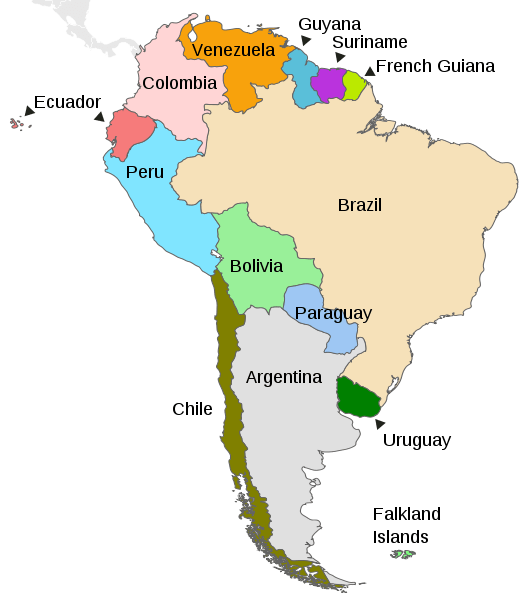
Map depicting the countries on the continent of South America.
Natural Geography of Peru
Geographic Regions
Peru is traditionally described as three broad longitudinal regions. Each of these regions comprises a different topography and sharply contrasting environment, thus forming the major terrestrial regions of the country.
- La Costa: The arid Costa, or coastal region, in the west
- La Sierra: The rugged Sierra, or the Peruvian Andes, in the middle
- La Selva: The wet and forested Amazonia, or jungle region, in the east
Three broad climatic regions can be readily distinguished, paralleling the three main geographic regions: coastal desert, mountain highland, and tropical forest.

Map of Peru, showing its three geographical regions and 25 departments.
Coastal Plain (La Costa)
The coastal region of Peru is a bleak, often rocky desert that runs the entire length of the country, from Ecuador in the north to Chile in the south. The landscape is punctuated by many rivers and streams that descend through steep, arid mountains in the east and empty into the Pacific Ocean in the west.
The coastal plain can be divided into three parts: north, central, and south. Generally speaking, the level of coastal land diminishes from north to south.
- North: In the northern region, the plain is typically about 30 - 50 km (20 - 30 mi) wide, with a maximum width of more than 140 km (90 mi) in the Sechura Desert.
- Central: The central coastal region is narrower than the northern region and is characterized by rough hills extending from the Andes to the ocean's shores.
- South: From Nazca southward to the Chilean border, the coast is lined mainly by low mountains with narrow valleys near the ocean.
Evidence of plant life is relatively rare in the barren desert of coastal Peru. However, Lomas (a mix of grasses and other herbaceous species) are common where coastal fog is heavy. In the north coast region, some parts of the desert are covered by epiphytes or by stands of sapote or algarroba (mesquite).
The most important feature of the coast is the enormous number of birds, marine mammals, and fish life in the coastal waters. These include anchovies, Corvina (sea bass), tuna, swordfish, and marlin. In addition, sea lions thrive in isolated parts of the coast. Birdlife is heavy on islands off the coast. The most important bird species are pelicans, cormorants, gannets, and gulls. In addition, Humboldt penguins, an endangered species, are found as far north as the Ballestas Islands near the Paracas Peninsula.
Coastal Desert Climate: From the Peruvian-Ecuadoran border south to northern Chile, the west coast of Peru has one of the Earth's driest climates. The Andes Mountains block rain-bearing winds from the Amazon Basin. Because of this, air masses moving toward the coast produce little rainfall, and northward-flowing cold water off the coast (the Humboldt Current) contributes little moisture to surface air masses. Temperatures in this coastal desert are not hot, however. Average temperatures in Costa range from 19 °C (66 °F ) in winter to 22 °C (72 °F ) in summer. Despite its dryness, some parts of the coastal region receive sufficient moisture from winter fogs (locally known as garúa) to support some vegetation.
Andean Highlands (La Sierra or Los Montañas)
The Sierra Highlands natural region, containing the Peruvian Andes, is the commanding feature of Peru. Hundreds of permanently glaciated and snowcapped peaks tower over the valleys. It includes the Altiplano plateau as well as the highest peak of the country, the 6,768 m (22,205 ft) Huascarán.
Several of the mountain groups found within the region of the Andean highlands include:
- Cordillera Negra
- Cordillera Blanca
- Cordillera del Cóndor
- Cordillera Huayhuash
- Cordillera Vilcanota
- Cordillera de Vilcabamba
The Sierra contains the headwaters of the streams that flow to the Pacific Ocean and the Amazon Basin. In the south, several rivers cross the Altiplano in Peru to empty into Lake Titicaca, the world's highest navigable body of water. The Andes' steep, desiccated Pacific flank supports only a sparse population in villages at infrequent springs and seepages. In contrast, tropical forests blanket the eastern side of the Andes. The most populous highland ecological zones lie between these extremes: the intermontane valleys, the higher uplands, and the grassy Puna-Altiplano plateau.
Slopes are relatively gentle in northern Peru. The Andes Mountains in central Peru are higher and more rugged. The ranges of the central zone form challenging barriers to movement. In southern Peru, the character of the Andes changes to that of a high plateau region; this is the Altiplano, with vast tablelands.
Two plant communities characterize the Peruvian highlands: puna grasslands at higher elevations and a mixture of native and introduced species at lower elevations. The Puna has an abundance of forage grasses and is home to the llama, alpaca, vicuña, and guanaco, which are native to the region. In addition, several species of eucalyptus have replaced native tree species.
Mountain Climates: The Sierra exhibits various climates that vary according to latitude, elevation, local winds, and rainshadow effects. Generally, temperatures decrease as elevation increases and rainfall decreases from north to south and east to west. Snow falls in the Sierra at higher elevations; many peaks have permanent snow.
Amazonia (La Selva)
The western slopes of the Peruvian Andes merge with the forested tropical lowlands of the Amazon Basin and form the region known as Amazonia or La Selva (the jungle), which occupies more than 60% of the area of Peru. In addition, dense cloud forests are found in the zone immediately adjacent to the Andes.
The region's physiography is characterized by rolling hills and level plains extending eastward to the borders of Colombia, Brazil, and Bolivia. Elevations are uniformly low, ranging from about 1,000 m (3,300 ft) at the eastern edge of the Andes to about 80 m (206 ft) above sea level along the Amazon River at the Peru-Brazil border.
Great rivers characterize Amazonia. The Amazon River has headwaters that rise in several places in the Peruvian Andes; one of the main branches, the Ucayali, originates in southern Peru. These tributaries, including the Marañón, Huallaga, and Ucayali, flow northward in deep valleys before turning east to join the Amazon.
Heavy tropical forest growth covers the eastern slopes of the Andes and the Amazon plains. As a result, the forests have a broad assortment of hardwood and softwood species that produce various forest products. These forests and waters provide habitat for thousands of plant, insect, and animal species. Mammals of this region include the jaguar, capybara, tapir, and several monkey species. In addition, there is a vast and colorful variety of bird and fish life. Reptiles and insects are abundant.
Tropical Forest Climate: Hot, humid conditions characterize the Amazonia climate of eastern Peru. Rainfall throughout the region is high, with precipitation typical throughout the year. There is minimal seasonal temperature variation.
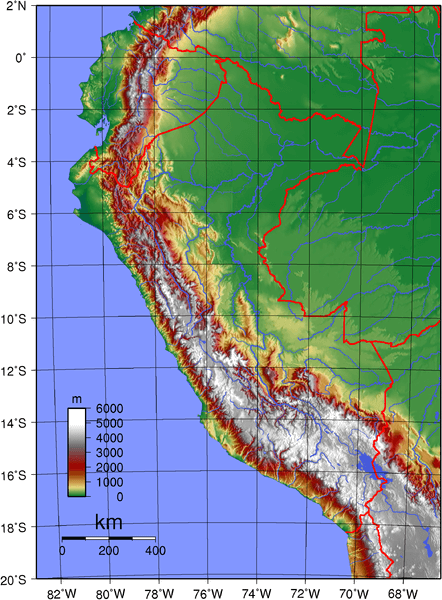
Topographic map of Peru.
Mountain Ranges
Peru hosts a diverse and awe-inspiring array of mountain ranges that form part of the more extensive Andes mountain range. These ranges stretch from north to south, shaping the country's topography and providing a home to unique ecosystems and cultural heritage.
See more: Mountain Ranges of Peru
Islands and Archipelagos
Peru is known for its diverse landscapes, including islands scattered along its Pacific coastline and lakes. While not as renowned for its islands and archipelagos as some other countries, Peru has several notable ones contributing to its biodiversity and cultural diversity.
See more: Islands and Archipelagos of Peru
Bodies of Water
Peru is blessed with many diverse bodies of water, including rivers, lakes, lagoons, gulfs, and bays. These water bodies are crucial for ecosystems and vital for sustaining livelihoods, supporting agriculture, and promoting tourism in this diverse and geographically rich country.
See more: Water Bodies of Peru
Administrative Divisions
Peru has been divided administratively into 25 regions (formerly known as departments) subdivided into provinces, except for the Lima Province, which does not belong to a region. One hundred ninety-six provinces are further subdivided into districts.
See more: Cultural Landscape of Peru
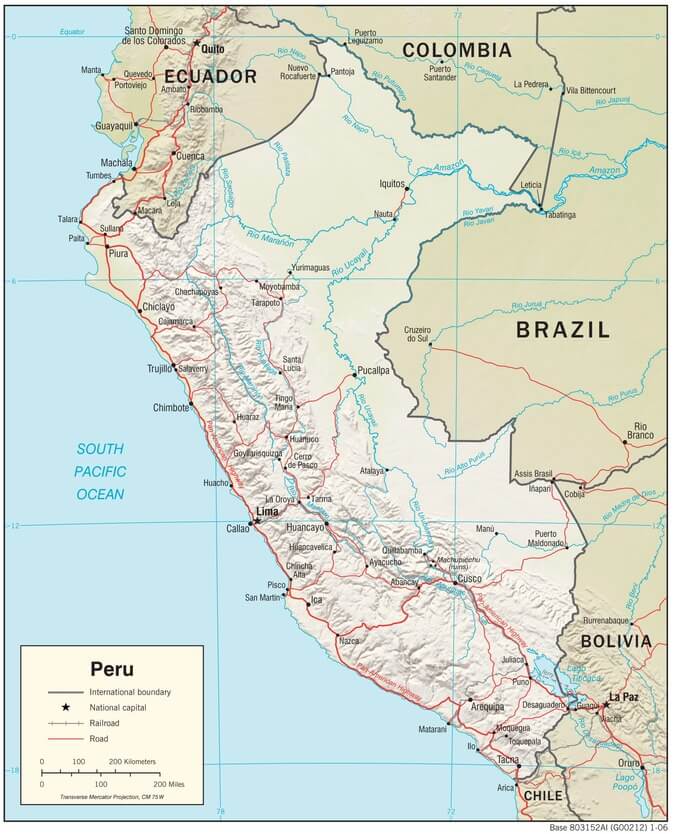
Peru physiographic map.
Natural Regions
Peru's biodiversity can be organized into four main biomes:
- Amazon
- Andean Highlands
- Drylands
- Tropical and Subtropical Dry Broadleaf Forest
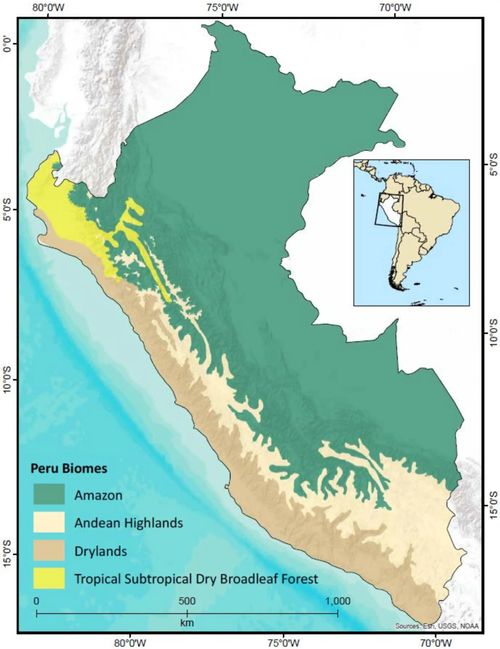
Map of Peru and its four biomes.
Ecological Regions
The following is a list of terrestrial ecoregions in Peru, as defined by the World Wide Fund for Nature (WWF). Peru is in the Neotropical realm. Ecoregions are classified by biome type - the major global plant communities determined by rainfall and climate.
Tropical and subtropical moist broadleaf forests
- Bolivian Yungas
- Eastern Cordillera Real montane forests
- Iquitos várzea
- Napo moist forests
- Peruvian Yungas
- Solimões-Japurá moist forests
- Southwest Amazon moist forests
- Ucayali moist forests
Tropical and subtropical dry broadleaf forests
- Marañón dry forests
- Tumbes-Piura dry forests
Montane grasslands and shrublands
- Central Andean dry puna
- Central Andean Puna
- Central Andean wet puna
- Cordillera Central páramo
Deserts and xeric shrublands
- Atacama desert
- Sechura desert
Mangroves
- Gulf of Guayaquil-Tumbes mangroves
- Piura mangroves
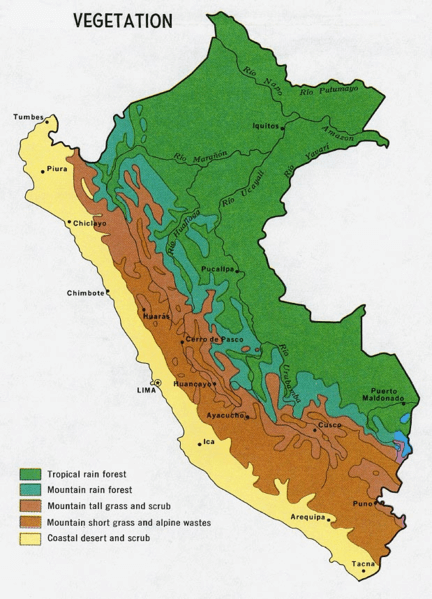
Vegetation map of Peru.
